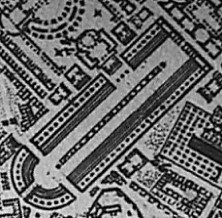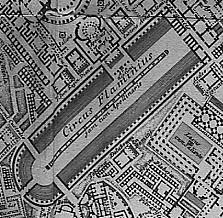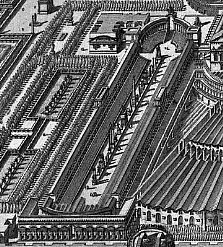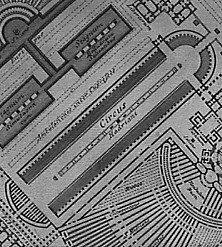a change of plan
2000.12.26
In all likelihood, the 20th century architects that looked at Giovanni Battista Piranesi's Ichnographia Campus Martius did not see this large plan of ancient Rome's Campo Marzio in the way that Piranesi first engraved it. That the Ichnographia exists in two different states is indeed a knowledge of which architecture's historical scholars and foremost practitioners have so far remained oblivious. The commonly published Campo Marzio plan does not match Piranesi's original rendition exactly. The change of plan is clearly evident upon a careful view of the circuses delineated throughout both versions of the plan. In the original version, each circus within Piranesi's Campo Marzio plan integrally engages its surrounding buildings, while each circus within the later version of the Ichnographia is redrawn completely and disengaged from its immediate surroundings. When, why, and by whom these changes occurred is perhaps to be found out by future scholarship. Meanwhile, it is best to document precisely what the two states of the Ichnographia Campus Martius are.
Campo Marzio circuses with temples
2001.02.05
...Piranesi's initial circus designs which incorporated temples (mostly to Apollo) may be because Piranesi followed the descriptions in Tertullian's The Shows.
Piranesi Campo Marzio in 2 states
2001.07.01 11:12
Dear John Wilton-Ely:
After spending over ten year redrawing Piranesi's Ichnographia Campi Martii utilizing CAD, I finally (on 14 May, 1999) went to the University of Pennsylvania's Fine Arts Library to see an original Ichnographia. I had been using a poster of the Ichnographia as the source of my redrawing, but I never saw an original of the large plan. To my astonishment, I found that the plan that I had been used to looking at, and indeed the plan as it is most often published, e.g., in your The Complete Etchings, is distinctly different in certain areas than the plan within the U of P's original Campo Marzio tome. I had documented the differences in April 2000, and published the differences online at www.quondam.com.
My question to you is whether anyone else has, to your knowledge, discovered that the Ichnographia Campi Martii has two states. I have yet to come across any such record. In fact, the only reference that comes close is within your The Complete Etchings, where, within the "List of G.B. Piranesi's Published Works," by Arthur M. Hind, there is noted a later(?) edition of the Campo Marzio in Thomas Ashby's collection that has only Italian text. It would be interesting to see whether the Ichnographia within Ashby's copy is of the first or second state.
I am not going to disclose here what and where the differences within the Ichnographia are, but I will say that the plan as most often published is not the original plan. At this point, I am personally satisfied in having 'discovered' the two states of the Ichnographia, but, since I am not an academic, I am not in a position to further research when the plan was altered, nor who altered the plan, nor even why the plan was altered (-- although I do have some preliminary theories). Answers to those questions might be something you could investigate. In any case, it appears The Complete Etchings is just a tad shy of being truly complete.
Sincerely yours,
Stephen Lauf
Re: Piranesi Campo Marzio in 2 states
2001.07.05 10:22
Dear Stephen Lauf,
I was fascinated to find your e-mail message regarding your new work on Piranesi's 'Ichnographia' on my return from teaching and reseraching in Italy.
First of all, I must congratulate you on what appears to be a remarkable discovery. I was certainly unaware of another version of the plan although I recall Hind's mention of the existence of the Ashby volume (probably still in the possession of the British School at Rome where he was Director). Naturally, I look forward to the publication of your work on the Ichnographia in August 2001 and, naturally, with regard to what you term 'lines of mutual respect', will treat in strict confidence anything you care to mention in advance.
My intention in publishing the Complete Etchings was not only to make Piranesi's amazing range of achievements easily available to a variety of disciplines and enquirers but to encourage further research and new discoveries like your own. I have never imagined that I had drawn the line below a definitive list of graphic works but one has to establish the 'core' corpus, even if there are bound to be discoveries in the future.
In the meantime, I imagine you will already be familiar with my 1983 paper on the 'Ichnographia', delivered at the Venice Piranesi Bicentenary conference in 1978. If you cannot get access to it, I would be delighted to send you a photocopy if you let me have your address in due course.
With best wishes,
John Wilton-Ely
| |
back to the Campo Marzio
2001.09.08 16:50
Hello John,
...getting back to the two states of the Ichnographia, here are some further thoughts and questions:
1. I believe the first state is the plan as it is NOT published in books today. If you look at the smaller and earlier plans of the Campo Marzio within the plates prior to the Ichnographia, you will see earlier plans of the Circus Flaminius the same as the Circus Flaminus plan within the first state Ichnographia. Furthermore, the aerial view the Circus Hadriani within the frontispiece corresponds in plan with the first state Ichnographia.
 
 
2. I think the circus delineations of the second state (which are all virtually identical to each other) are in fact delineations based on the Circus of Maxentius (rather than the Circus Maximus). This is somewhat significant in that (according to my research and interpretation of the Ichnographia as a double narrative relating Rome's inversion from pagan city to Christian city) Maxentius is exactly the ruler of Rome immediately prior to Constantine's Christian efforts.
3. ...now knowledgable of the practice of damnatio memoriae, I wonder if Piranesi purposefully 'erased' portions of the Ichnographia as a reenactment of the damnatio memoriae practice, and, like some extant examples of dm inscriptions, if he then purposefully followed up with a palimpsest (of another plan) over the erasure.
4. I realized that I have yet to see an actual print version of the second state of the Ichnographia. All I've ever seen is an actual first state (1761) version. Do you know if you've seen an actual eighteenth cent. print version of the second state? Moreover, did you happen to make a trip to Rome to see which state the actual engraved plates are in? It is the current state of the plates that would surely identify the second state (that is, unless someone long ago altered a reproduction, and it happens to be an altered reproduction that's been printed in books all these years).
5. I also believe that it was indeed Piranesi that made the changes. My main reasoning here is that Piranesi was very likely the only person that could have made the changes with such dexterity.
As to Tafuri, I have documented so many cases within the Ichnographia that carried explicit meaning and message on Piranesi's part, that all of Tafuri's theorizing that the Ichnographia is indicative of and/or percursor to the modern meaninglessness of architectural form is plainly and emphatically wrong. What Tafuri obviouly never did, but definitely should have done, is to translate all the Latin labels that Piranesi applies to virtually all the plans of the Ichnographia. It is only through reading the labels and the planimetrics in combination that the full meaning of Piranesi's Campo Marzio comes through.
All the best,
Steve Lauf
Piranesi's Continual Double Theaters
2001.11.26
|